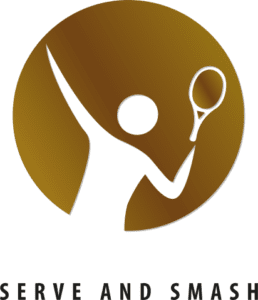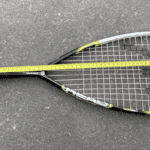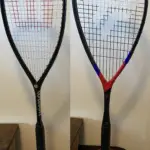This post may contain affiliate links.
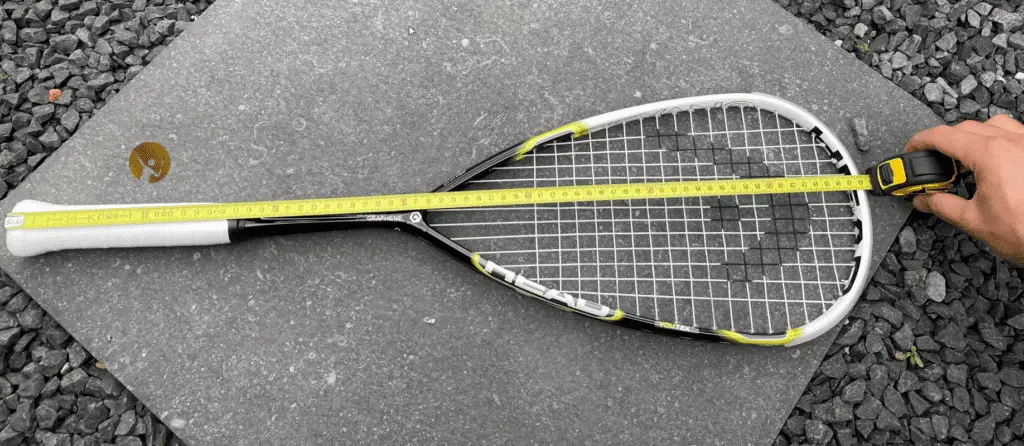
Squash rackets do come in a lot of different colors and materials. On top of that, there are different racket types you can choose from, but do they actually differ in terms of their size? I did my own research and analysis, and as you’ll find out, I will use the results to answer this in great detail.
Squash rackets are not the same size and differ in both the size of the racket head, as well as the length of the racket. The difference in racket head size allow players to choose between either a forgiving racket in terms of their sweetspot or a racket that can generate more power.
Now that we know that squash rackets do come in different sizes, how do they differ? Let’s look at the size of the racket head as well as the length of the racket.
As I discussed the optimal racket weight in this article , I concluded the following: There is no ‘one-size-fits-all’ when it comes to racket weight. However, the conclusion here is very similar: There is no ‘one-head-size-fits-all’ when it comes to racket head size.
, I concluded the following: There is no ‘one-size-fits-all’ when it comes to racket weight. However, the conclusion here is very similar: There is no ‘one-head-size-fits-all’ when it comes to racket head size.
There is no ‘one-head-size-fits-all’ when it comes to racket head size.
If you are interested in specific questions, go ahead and jump directly to the answers by clicking the sections. No worries, you can always come back to this overview :
Head size
Racket length
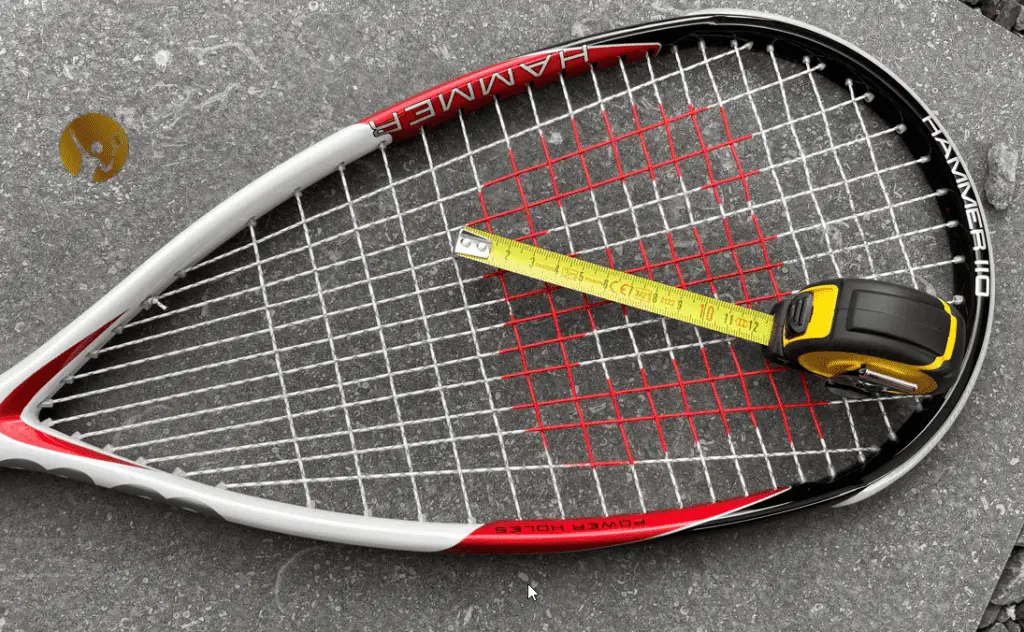
What is the average head size of a squash racket?
The average head size is 491.0 cm2/ 76.1 square inches for a squash racket, measured as the surface that is covered by the racket strings. On average the head size decreases as the skill level increases. This implies that squash rackets targetted at beginners tend to have a bigger head size compared to rackets targetted at more advanced players. This consensus is also supported by my own research since I did find that the average head size for beginners is 492.4 cm2 / 76.3 in2, while this is 487.6 cm2 / 75.6 in2 for rackets targeted at advanced players.
This makes sense if you know the following: a bigger head size means a bigger sweet spot and as a consequence, the racket is more forgiving if you hit it off-centre. Beginners tend to have less control over their racket and therefore are less likely to hit the ball exactly in the centre of the racket head.
Why wouldn’t everyone benefit from a bigger head size racket, I hear you think? Well, what rackets with bigger head sizes win in their forgiving quality, they lack in power. This is exactly why advanced players benefit from smaller racket head sizes since they are better able to still hit the ball in the centre of the racket blade. With this added power, they can place the ball anywhere on the court, making the game even more intense. If you want to know how intense, definitely check out this other article I wrote on this topic.
As of now, all seems to be quite logical, but you’re in for a change. What I did find in my own research while looking at the average head size for each targeted audience, struck me by surprise. While the average head size for beginner rackets is bigger than for advanced, it is not the biggest number on average. Actually intermediate rackets have an average head size of 497.8 cm2 / 77.2 in2.
| Target audience | Average head size |
|---|---|
| Kids | 493.3 cm2 / 76.5 in2 |
| Beginner | 492.4 cm2 / 76.3 in2 |
| Intermediate | 497.8 cm2 / 77.2 in2 |
| Advanced | 487.6 cm2 / 75.6 in2 |
Well, the next question that arises is of course how to interpret this result. As mentioned, this result took me by surprise as well so I decided to dive deeper into the data.
First of all, I divided the head sizes into three ranges, rackets smaller than 480 cm2 (74.4 in2), rackets between 480 and 500 cm2 (74.4-77.5 in2) and rackets bigger than 500 cm2 (77.5 in2). It is apparent that on average around 4 out of 5 rackets fall within the 480-500 cm2 range. While zooming in on this data, there is some disparity amongst the different targetted players. In the case of beginner rackets, this number is 76.9%, while this is 84.0% and 75.8% for respectively intermediate and advanced rackets. For rackets aimed at kids, almost all (91.7%) fall within this range.
While it is apparent that the racket head size is concentrated between 480 – 500cm2, there is another interesting observation. More than half of the intermediate and kids rackets had a head size of exactly 500cm2 (77.5 in2), while this is the case for 38.5% of beginner rackets and 43.6% of advanced rackets. As you will find out in the next section, this 500cm2 is not just a randomly picked head size.
| Target audience | Rackets with maximum head size |
|---|---|
| Kids | 75.0% |
| Beginner | 38.5% |
| Intermediate | 52.0% |
| Advanced | 43.6% |
Maximum size of the racket
The maximum area that is covered by the strings is 500 square centimetres (or 77.5 square inches) according to the official regulations from the WSF. This implies that if you want to partake in any official matches you can’t play with a squash racket that has a bigger strung area than 500 cm2. But this does not mean you can’t play any recreational matches with this bigger racket.
In another article, I make the case that you don’t need to worry about buying a racket that exceeds the official maximum racket weight. To verify whether this is also the case for the maximum racket head size, I looked at over 100 rackets. Based on my research I concluded that there are definitely rackets on the market that exceed the maximum strung area.
Overall, only 3.6% of the rackets exceeded the maximum head size. Since this maximum size becomes only relevant if you want to partake in official matches, you would expect the ones exceeding this limit to be targeted at beginners. Strangely enough, 12.0% of intermediate rackets exceeded the maximum size of 500 cm2, while for beginners rackets this was 7.7%. Rackets aimed at advanced players and children did not exceed the maximum size.
| Target audience | Rackets that comply with maximum head size |
|---|---|
| Kids | 100.0% |
| Beginner | 92.3% |
| Intermediate | 88.0% |
| Advanced | 100.0% |
Therefore, you generally don’t need to worry about exceeding the maximum head size on a recreational level. Nevertheless, you might want to check before playing WSF regulated matches, but that is if you play with an intermediate racket.
What is the average length of a squash racket?
The average length is 67.6 cm / 26.6 inch for a squash racket, measured as the distance between the bottom of the racket handle and the top of the racket head. The average length decreases slightly as skill level increases.

This implies that squash rackets targetted at beginners tend to be longer compared to rackets targetted at more advanced players. This consensus is also supported by my own research, since I did find that the average length for beginners is 68.8 cm / 27.1 inch, while this is 68.5 cm / 27.0 inch for rackets targeted at both intermediate and advanced players. For kids the average length is 59.3 cm / 23.3 inch. It is worth noting that the length is also the largest measurement of the squash racket.
| Target audience | Average length |
|---|---|
| Kids | 59.3 cm / 23.3 inch |
| Beginner | 68.8 cm / 27.1 inch |
| Intermediate | 68.5 cm / 27.0 inch |
| Advanced | 68.5 cm / 27.0 inch |
To determine whether the average length is skewed due to some outliers, I looked at the data in greater detail. All rackets targetted at adults were starting from 62.5 cm / 24.6 inch, while this was only the case for 54.5% of the kids’ rackets. It makes sense that kids’ rackets are shorter in terms of their total racket length in order for them to play more effectively. As we’ve seen earlier, the average head size for kids is not neccesarily smaller. This adds to reasoning that it is easier for children to handle the racket whilst enjoying the forgiving quality of a bigger head size.
Enough kids talk, back to the adult rackets, shall we?
As we concluded earlier, the average racket length decreases as skill level increases. While 91% of all beginner rackets are between 62.5-70.0 cm (24.6-27.6 inch), all intermediate and advanced rackets fall within this range. Even more specifically, 91.9% and 87.5% of respectively advanced and intermediate rackets have a length of 68.6 cm / 27.0 inch. For beginners and kids this portion is respectively 72.7% and 9.1%.
Although there is a difference in terms of length between the different targetted player groups, the difference is only small. Does this then also mean that length is insignificant importance? Yes, I would argue that length of the racket is one of the least important factors while looking for a racket. If you are wondering what other factors (besides racket head size) are important, definitely check out this article .
.
What is the maximum length of a squash racket?
The maximum length is 68.6 centimetres (or 27.0 inches) according to the official regulations from the WSF. As skill level increases, the percentage of rackets that have the exact maximum length increases as well.
| Target audience | Rackets with maximum length |
|---|---|
| Kids | 9.1% |
| Beginner | 72.7% |
| Intermediate | 87.5% |
| Advanced | 91.9% |
Advanced players benefit from the maximum allowed racket length, since it allows them to have a longer reach to get the ball. At this level, these aspects need to be optimized to perform at their highest capacity.
However, as we see next, there are rackets that exceed the maximum length. These rackets are targetted at beginners. Adhering to the maximum racket length implies that if you want to partake in any official matches you can’t play with a squash racket that is longer than 68.6 cm. But this does not mean you can’t play any recreational matches with a longer racket. Nevertheless, this explains why it is less relevant for beginner rackets if it exceeds the maximum length.
| Target audience | Rackets that comply with maximum length |
|---|---|
| Kids | 100.0% |
| Beginner | 91.9% |
| Intermediate | 100.0% |
| Advanced | 100.0% |
Overview official squash racket measurements
Below you will find an overview of the official maximum measurements for squash rackets according to regulated body, WSF. Note that these measurements can be subjected to change if the WSF decides to. Nevertheless they needs to give a two-year notice before any change become effective. This allows the manufacturers to redesign their rackets to adhere to these regulations. The WSF needs to approve those (re)designed rackets before they can be used in WSF officiated matches.
| Dimension | Maximum measurement |
|---|---|
| Head size | 500 cm2 / 77.5 inch |
| Racket length | 68.6 cm / 27.0 inch |
| Racket width | 21.5 cm / 8.46 inch |
| Frame width | 0.7 cm / 0.28 inch |
| Frame depth | 2.6 cm / 1.02 inch |
